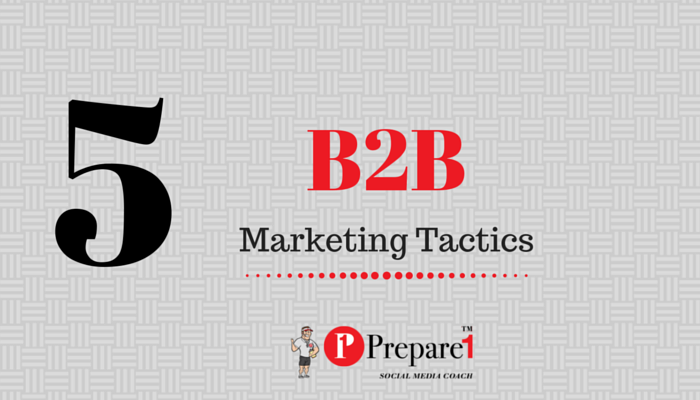
What B2B content marketing tactics do you use?
Are those tactics as effective as you would like them to be?
B2B marketers, as in years past, continue to be heavily focused on creating engaging content, citing it as the top priority for their internal content creators over the next year.
B2B marketers have consistently cited website traffic as their most often used metric.This year however, they are placing more importance on sales lead quality, sales, and higher conversion rates.
B2B marketers allocate 28% of their total marketing budget, on average, to content marketing. The most effective allocate 42%, and the most sophisticated/mature allocate 46%.
B2C buyers are driven by different motivations — usually, feeling safe, secure and informed — than B2B purchasers. As a result, both the intent and the messaging of your content marketing campaigns must be different.
Key takeaway: Those creating B2B content should keep the imperative of building thought leadership in mind. Those who are more active with B2C content should consider other goals, such as establishing exclusivity or cost effectiveness.
B2B STRATEGY
B2B marketers use content to attract and retain customers.
Successful B2B content marketers have two critical habits.
- They document their content marketing strategy. They get the strategy out of their head and into action.
- They review the strategy on an ongoing basis, especially with their team. Neither of these habits is rocket science, but they are musts for highly effective content marketers.
The sad state of content marketing: Where has the strategy gone?
If you’re not doing content marketing, you’re in an awkward and kind of lonely position.
Something’s wrong here. If businesses don’t have a “documented content strategy,” then what are they doing? Flying by the seat of their pants? Churning out content with no strategy?
I work with brands and marketers, and I see the same thing going on everywhere: Businesses are doing content marketing with absolutely no strategy.
Some have a misguided idea of strategy. Some have a vague and wispy idea of a strategy. Some have a wish for strategy. Some people don’t know what strategy is. The majority are just doing content marketing for the sake of content marketing.
Answer the Big Questions
- Why are you doing this?
- Who are you?
- Who are you reaching?
- What are you trying to accomplish?
B2B TACTIC USAGE
There are some differences in B2B and B2C marketing; however, at the end of the day we’re all looking to tell a story about our brand to develop relationships with our target audience. B2B marketing means being able to tell that story to different people at different levels of the business and having your content resonate with each of them.
Digital content has made that possible by allowing us to hone in on each level of the target audience and track, through analytics, the response we’re receiving back from those visitors.
All in all, content marketing has allowed us to see the people behind the businesses once again and target them much more effectively, resulting in stronger relationships and ultimately a stronger conversion.
According to a recent survey by Content Marketing Institute, B2B marketers are using more tactics, on average, than they did last year (13 vs. 11).
How many of these content marketing tactics does your organization use?
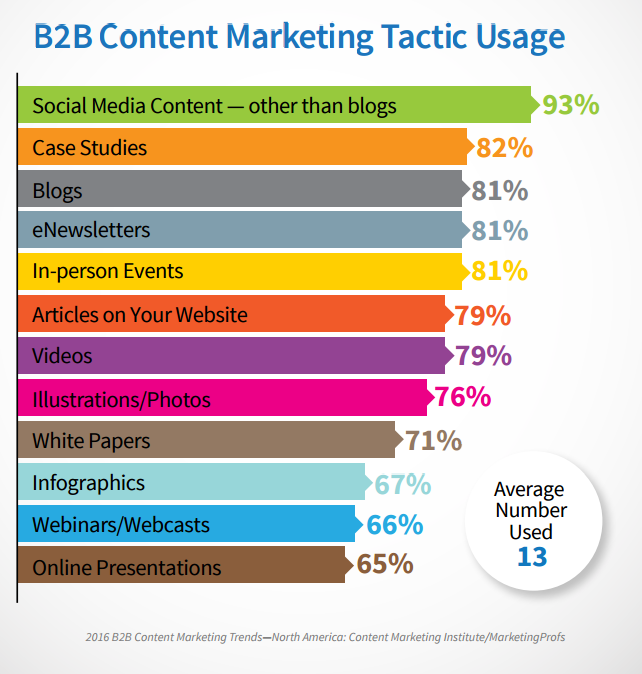
Note: Fewer than 50% of B2B marketers said they use the following tactics:
- Research Reports (49%)
- Microsites/Separate Website Hubs (47%)
- Branded Content Tools (42%)
- eBooks (39%)
- Print Magazines (36%)
- Books (30%)
- Digital Magazines (29%)
- Mobile Apps (28%)
- Virtual Conferences (25%)
- Podcasts (23%)
- Print Newsletters (22%)
- and Games/Gamification (12%)
Social media content (other than blogs) remains the most often used tactic (93% this year vs. 89% last year).
The use of the following tactics increased most:
- Infographics (50% last year vs. 58% this year) – B2B produced more last year yet B2C overtook them this year.
- Illustrations/photos (69% last year vs. 76% this year) – Still lags behind B2C.
- Online presentations (36% last year vs. 48% this year)
Other than the 3% decrease in the use of social media content, along with a slight decrease for branded content tools and podcasts (-1% for both), the use of all other tactics increased.
B2B EFFECTIVE TACTICS
In-person events, which has been rated the most effective tactic for the last six years, increased from
69% to 75%. Effectiveness ratings increased for all the other tactics shown here as well, except for blogs (60% last year vs. 59% this year). The biggest increase was for infographics (50% last year vs.
58% this year).
Even though in person events ranked 5th for most often used content marketing tactic, they ranked No. 1 when content marketers were asked which tactics were the most effective. Slightly below in-person events, 66 percent of the survey participants rated webinars as the 2nd most most effective form of content marketing.
There was not that much of a gap when rating effectiveness of content marketing cases studies, with 65 percent of the survey respondents putting it slightly below In-person events and Webinars.
There seems to be a disconnect in tactics and effectiveness.
Video was ranked 7th in terms or a tactic, yet it’s effectiveness rates 4th. Visuals Matters.
Social Media other than blogs topped the tactics list with case studies close behind. With 69 percent of B2B content marketers claiming that their organization offered e-newsletter subscriptions, it was by far the most popular form of subscription-based content marketing. Second were blogs at 81 percent, followed by videos at 79 percent.
The top 3 content tactics B2C marketers use:
- Social media (93% of respondents)
- Case Studies (82% of respondents)
- Blogs (81% of respondents).
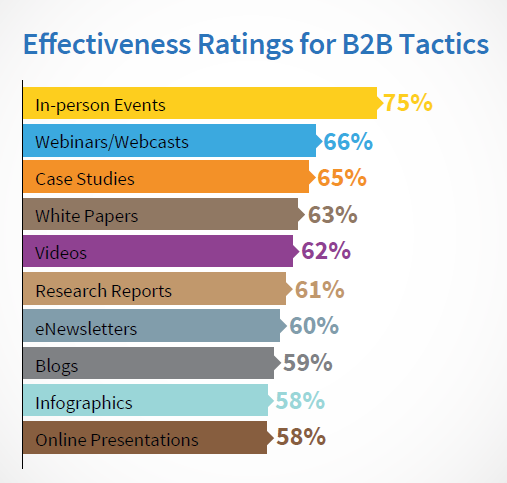
Effectiveness ratings increased for all tactics shown here, except for blogs (60% last year vs. 59% this year).
The greatest effectiveness rating increase was for infographics, up 21 percentage points (50% last year vs. 58% this year).
How effective are the tactics your organization uses?
VISUAL CONTENT MATTERS
A study by Wyzowl respondents said they remember 80% of what they see, but only 20% of what they read, and it becomes clear that visual marketing is critical to keeping you:
- Top of mind
- Relevant, and
- Memorable
But knowing how to incorporate visual marketing is still a challenge for most businesses.
- When people hear information, they’re likely to remember only 10% of that information three days later. However, if a relevant image is paired with that same information, people retained 65% of the information three days later. (Source)
- Researchers found that colored visuals increase people’s willingness to read a piece of content by 80%. (Source)
- 46% of marketers say photography is critical to their current marketing and storytelling strategies. (Source)
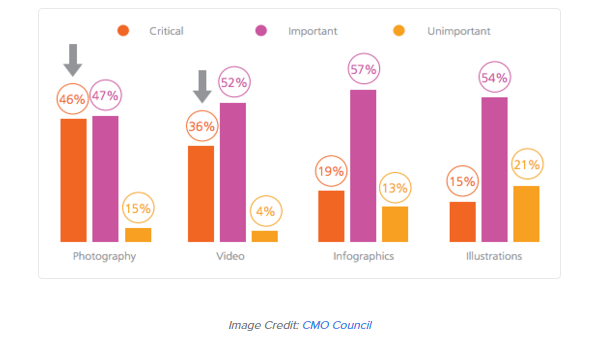
Image Credit: CMO Council
- 34% of marketers selected visual assets as their most important content, behind blogging (45%) and before videos (19%). (Source)
- 65% of senior marketing executives believe that visual assets (photos, video, illustrations and infographics) are core to how their brand story is communicated. (Source)
- Content with relevant images gets 94% more views than content without relevant images.(Source)
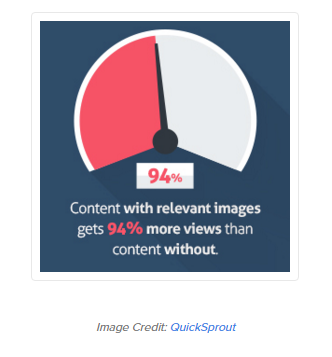
Image Credit: QuickSprout
- 73% of content creators plan to prioritize creating more engaging content in 2016, and 55% plan to prioritize creating visual content. (Source)
- 39% of marketers believe that more of their budget should be allocated to the acquisition or creation of compelling visual assets. (Source)
- Only 27% of marketers have a process in place to aggregate, organize, and manage the visual assets being used across their marketing teams. (Source)
VIDEO CONTENT STATS
Video is taking content marketing by storm, but you’ll have to do more than just make one to realize its full potential.
If it were five years in the future, would you be reading this article or would you be watching it? As online video continues its inimitable rise, it’s an interesting question to ponder.
By 2017, video will account for 69% of all consumer internet traffic, according to Cisco. Video-on-demand traffic alone will have almost trebled. Leafing through a swathe of statistics on the subject, I’m hard pressed to find any indicator that doesn’t suggest rapid growth.
With online video quickly becoming a key means for people to satisfy their information and entertainment needs, small businesses that fail to include it in their internet marketing strategies will do so at their peril.
- 51.9% of marketing professionals worldwide name video as the type of content with the best ROI. (Source)
- Shoppers who view video are 1.8 X more likely to purchase than non-viewers. (Source)
- Using the word “video” in an email subject line boosts open rates by 19%, click-through rates by 65% and reduces unsubscribes by 26%. (Source)
- Midway through 2015, mobile video plays exceeded 44% — up 74% from 2014 and up a whopping 844% since 2012. (Source)
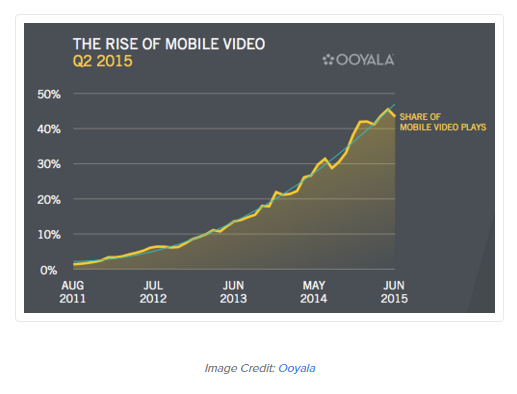
Image Credit: Ooyala
- Between April 2015 and November 2015, the amount of average daily video views on Facebook doubled from 4 billion video views per day to 8 billion. (Source)
- In July 2015, Periscope users were watching 40 years’ worth of videos every day. (Source)
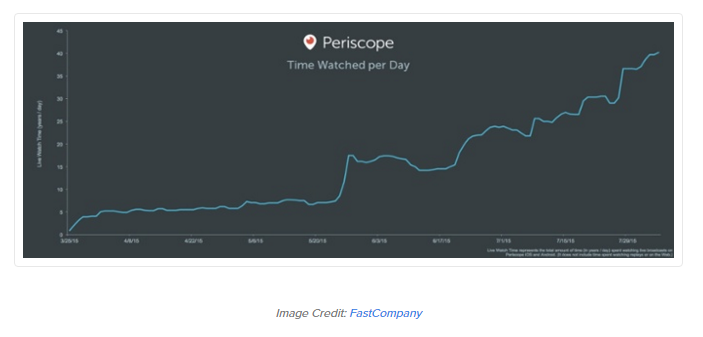
Image Credit: FastCompany
- In Q2 of 2015, mobile phones (34%) and tablets (15%) combined for 49% of video ad impressions — up from 38% in Q1 of 2015. Publishers saw PC impressions drop from 62% to 50% in the previous quarter. (Source)
- Syndacast predicts 74% of all internet traffic in 2017 will be video. (Source)
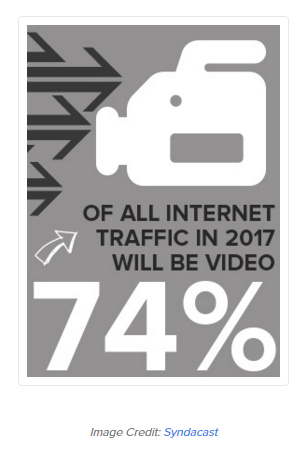
Image Credit: Syndacast
SOCIAL MEDIA CONTENT STATISTICS
- Articles with an image once every 75-100 words got double the number of social shares than articles with fewer images. (Source)
- 60% (of millennials) believe that in the next five years, everything will be done on mobile devices.
- 67% of B2B buyers rely more on content to research and make purchasing decisions than they did a year ago. (source)
- Nearly 64% of B2B technology buyers indicated that they read between 2 to 5 pieces of content before making a purchase. (source)
- 68% of business owners believe outside reviews (done by some person or entity not related to the company) are the most important indicator of whether or not they can trust a new B2B vendor. (source)
- 60% of B2B marketers consider mobile as a “crucial enabler” and conduit of their overall sales. (source)
- Four times as many online consumers would rather watch a video about a product than read about it. (source)
- 71% of online marketers use visual assets in their social media marketing. (Source)
- B2B marketers are placing more importance on video content.
- Visual content is more than 40X more likely to get shared on social media than other types of content. (Source)
- Facebook posts with images see 2.3X more engagement than those without images. (Source)
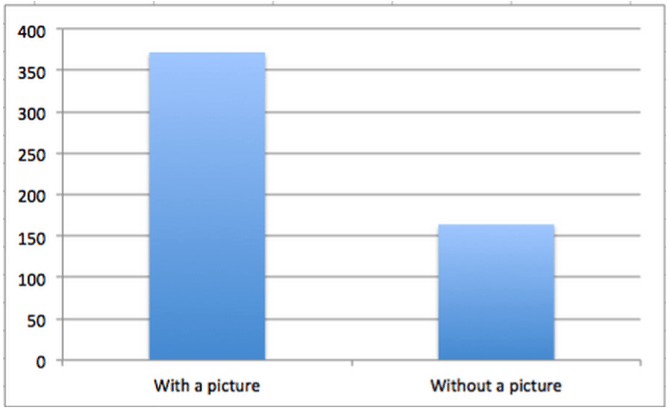
Image Credit: BuzzSumo
Our focus has shifted from Social Media to VISUAL Social Media. We are drawn to “visual content” online in more ways than ever before.
The opportunity this provides for B2B business is hugh, but not as massive as B2C. How you use these tactics to increase effectiveness is your focus. Those that get it will propel going forward, and those that don’t will be passed.
What lane do you want to be in?
JOIN US FOR OUR UPCOMING
SOCIAL MEDIA SEMINAR SERIES
- Facebook Ads – How to boost sales and leads – Jan. 28th
- YouTube & Video – How to create engaging videos that boost sales – Feb. 11th
- Visual Content for Business – How to get your business to stand out – Mar.10th
About Blair

Blair Evan Ball is a Social Media Coach and founder of Prepare1, a company that works with businesses, individuals and non-profits. He is a former executive with a Fortune 50 company, and his national division did $1Billion+ in sales annually.
Blair has written three e-books: Facebook for Business Made Easy, Facebook Pages for Business Made Easy, and WordPress Blog Setup Made Easy.
Blair also educates, trains entrepreneurs and business professionals how to amplify their brand, increase revenues, and raise more funds.
![[Study] How Will Businesses Change Their Social Media Activities 5 Golden Rules for Sharing on Social Media](https://www.prepare1.com/wp-content/uploads/2014/03/COACH-logohat-162x300.jpg) The Race is ON! | PREPARE | Get into the Game and WIN!
The Race is ON! | PREPARE | Get into the Game and WIN!

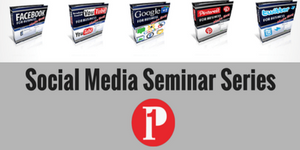



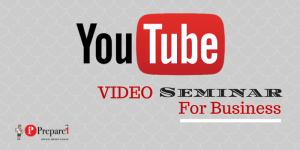





Thanks for sharing this informative blog. Keep update your blog
Comments on this entry are closed.